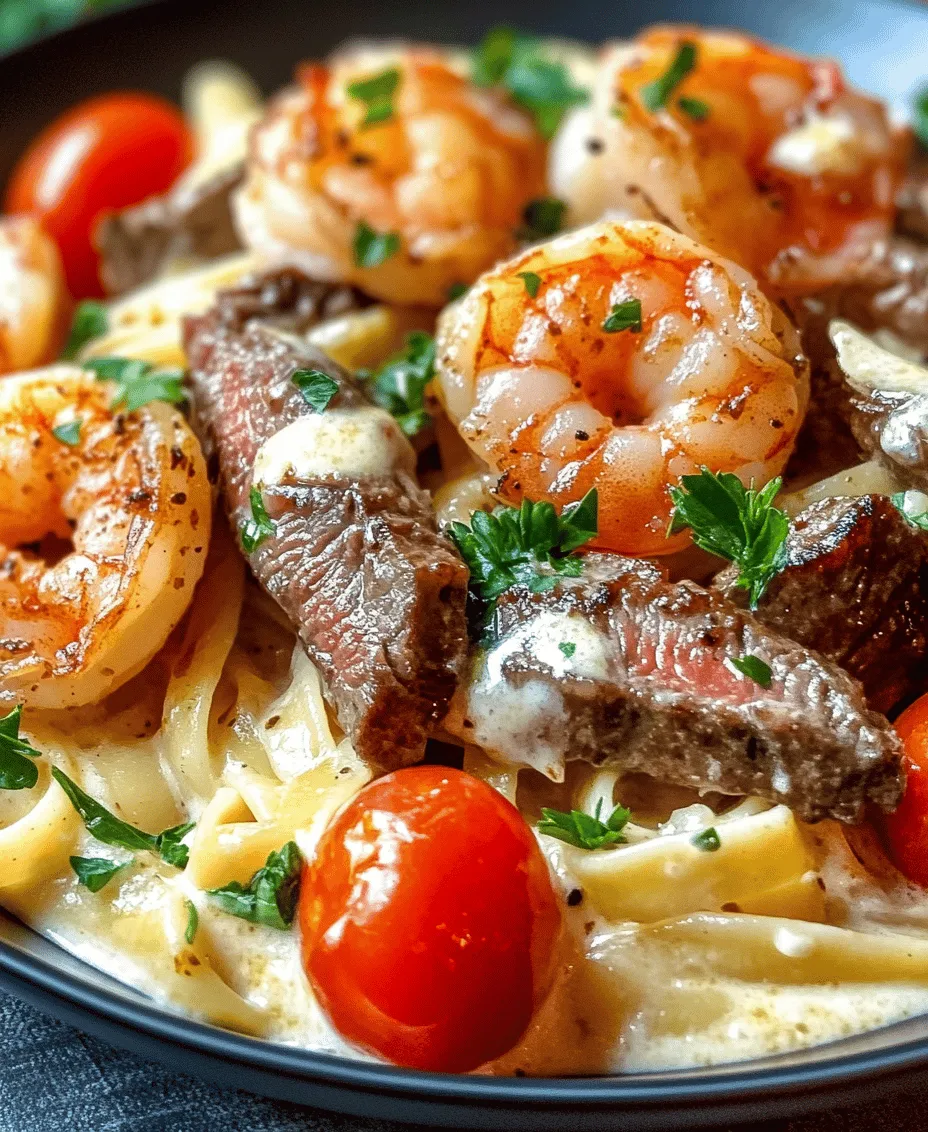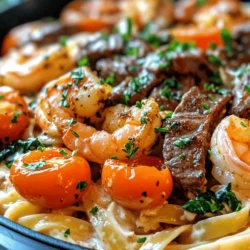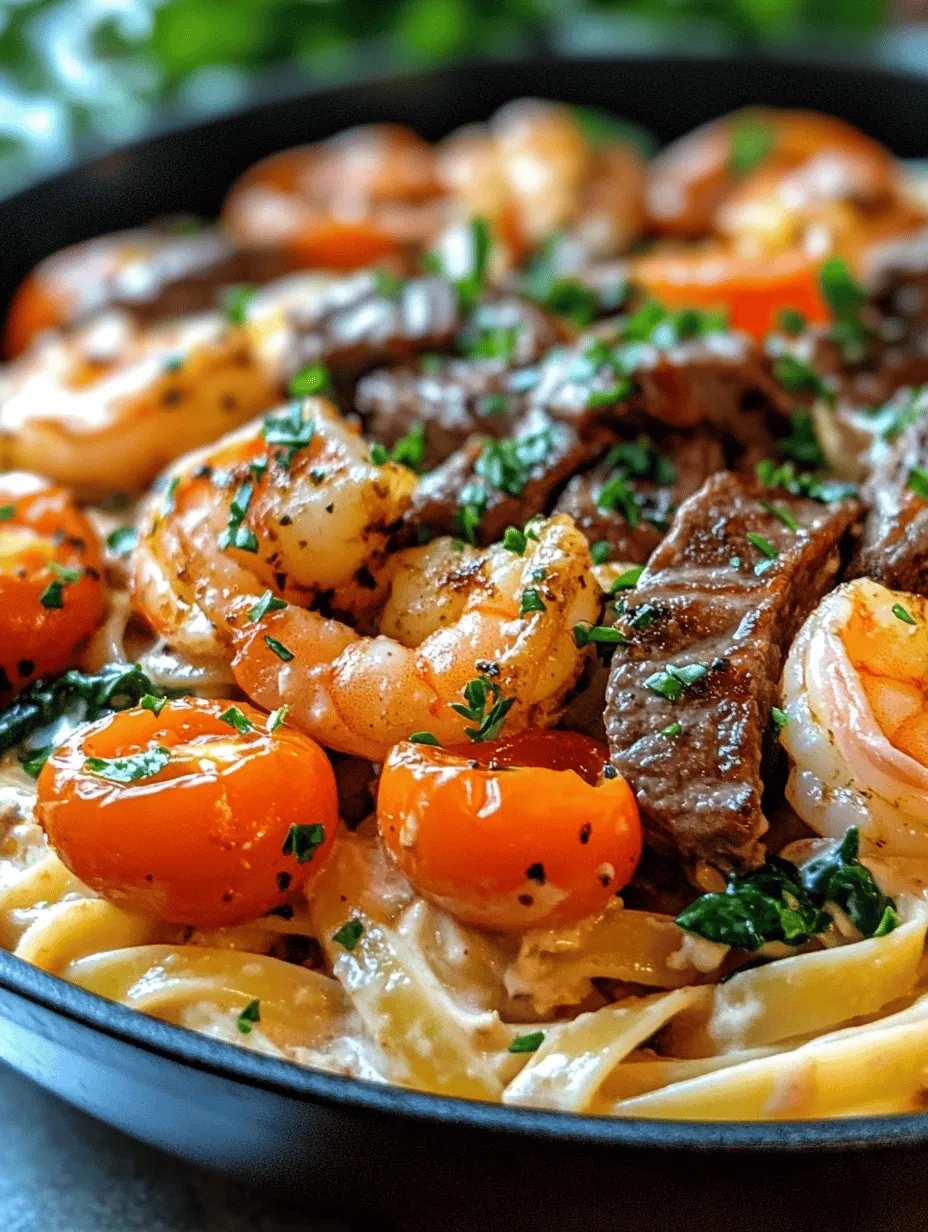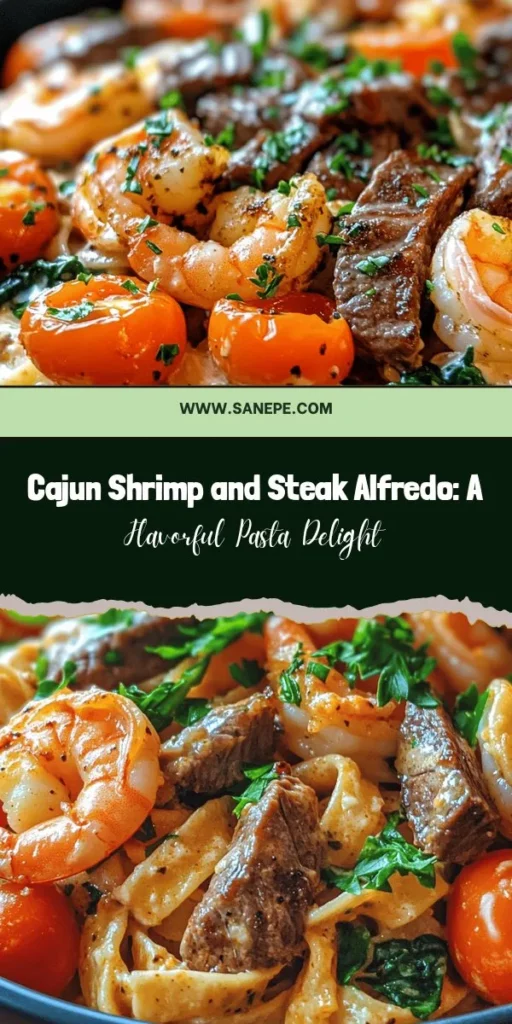Introduction
Cajun cuisine, with its vibrant flavors and rich history, stands as a testament to the cultural melting pot of Louisiana. Born from the traditions of the French Acadians who settled in the bayou, Cajun cooking reflects a unique blend of French, African, Spanish, and Native American influences. It is characterized by its bold flavors, hearty ingredients, and an emphasis on communal cooking, making it a beloved culinary tradition across the United States and beyond.
Among the myriad of dishes that celebrate this spicy and savory cooking style, Cajun Shrimp and Steak Alfredo Pasta emerges as a standout. This dish harmoniously melds the richness of creamy Alfredo sauce with the robust flavors of Cajun spices, succulent shrimp, and tender steak. The result is a comforting pasta dish that appeals to seafood lovers and meat enthusiasts alike, offering a delightful fusion of flavors that is both indulgent and satisfying.
The allure of combining seafood and steak in a creamy pasta dish lies not only in the taste but also in the visual appeal. The vibrant colors of the shrimp and steak against the creamy backdrop of Alfredo sauce make for an enticing presentation that is sure to impress. Whether you’re hosting a dinner party or simply looking to elevate your weeknight meal, this dish promises to deliver both comfort and sophistication.
Understanding Cajun Cuisine
To truly appreciate Cajun Shrimp and Steak Alfredo Pasta, it’s essential to understand the roots of Cajun cuisine. The term “Cajun” originates from the French-speaking Acadians who were exiled from Canada in the 18th century and settled in the wetlands of Louisiana. Over the years, they adapted their cooking styles to incorporate local ingredients, leading to the development of a distinctive culinary tradition.
Cajun cooking is known for its use of fresh, locally sourced ingredients, which often include seafood, meats, and a variety of vegetables. Staples like rice, beans, and corn are frequently featured, providing the hearty foundation of many Cajun dishes. One cannot discuss Cajun cuisine without mentioning its hallmark spices and seasonings. A blend of paprika, cayenne pepper, garlic powder, onion powder, and various herbs creates the iconic Cajun seasoning that imbues dishes with their signature heat and flavor.
The use of spices is crucial in Cajun cooking, as they elevate the natural taste of the ingredients and add layers of complexity. Techniques such as sautéing, braising, and grilling are commonly employed, allowing the spices to meld with the ingredients while enhancing their inherent flavors. This culinary philosophy is what makes Cajun cuisine so beloved and why it has gained popularity far beyond its geographical roots.
Key Ingredients Commonly Found in Cajun Dishes
Several ingredients are fundamental to the essence of Cajun cooking. These include:
– Seafood: Shrimp, crab, and fish are commonly used, reflecting the region’s proximity to the Gulf of Mexico.
– Meats: Sausage, chicken, and, of course, steak are staples that provide heartiness to dishes.
– Vegetables: The “holy trinity” of Cajun cooking—bell peppers, onions, and celery—forms the base for many recipes, providing depth and flavor.
– Spices: Cajun seasoning, hot sauce, and fresh herbs like parsley and thyme are essential for achieving the characteristic flavor profile.
This foundation of ingredients allows for creativity and adaptability in Cajun recipes, making it possible to cater to various tastes and preferences.
Ingredients Overview
Now that we’ve delved into the essence of Cajun cuisine, let’s focus on the key components of our Cajun Shrimp and Steak Alfredo Pasta. The beauty of this dish lies in its simplicity and the quality of ingredients used.
Main Ingredients
1. Fettuccine Pasta: The base of our dish, fettuccine, is a flat pasta that holds sauce beautifully, allowing each bite to be rich and creamy.
2. Shrimp: Fresh, deveined shrimp not only add a delightful seafood flavor but also a pop of color to the dish. Choosing large shrimp ensures a satisfying bite.
3. Steak: A tender cut of steak, such as sirloin or ribeye, provides a hearty contrast to the shrimp and contributes to the overall richness of the dish.
4. Alfredo Sauce: Made from butter, heavy cream, and Parmesan cheese, this sauce creates a lush coating for the pasta. Making it from scratch allows for better control over flavor and consistency.
5. Cajun Seasoning: This mix of spices is crucial for imparting the signature flavors of Cajun cuisine. You can either purchase a pre-made blend or create your own with spices like paprika, cayenne, garlic powder, and thyme.
6. Garlic: Freshly minced garlic enhances the depth of flavor, adding a robust aroma and taste to the dish.
7. Parmesan Cheese: Freshly grated Parmesan cheese not only enriches the Alfredo sauce but also serves as a tasty garnish.
8. Olive Oil: Used for cooking the steak and shrimp, olive oil adds a subtle flavor and helps achieve a perfect sear.
Importance of Fresh Ingredients
When it comes to any pasta dish, the freshness of ingredients significantly impacts the final result. Fresh shrimp and steak not only taste better but also enhance the overall texture of the dish. The creamy Alfredo sauce is best when made with high-quality butter and fresh Parmesan cheese, as these ingredients create a smooth, velvety finish that envelopes the pasta beautifully.
Opting for fresh herbs and vegetables also adds vibrancy to the dish, making it visually appealing while providing an aromatic experience that complements the bold flavors.
Step-by-Step Preparation Guide
Now that we have a comprehensive understanding of Cajun cuisine and the essential ingredients for our Cajun Shrimp and Steak Alfredo Pasta, let’s dive into the preparation process. This step-by-step guide will ensure that you achieve a delicious and satisfying dish that highlights the best of both seafood and steak.
Cooking the Fettuccine
The first step in preparing this dish is to cook the fettuccine pasta. Achieving the perfect al dente texture is crucial, as it will hold up well against the creamy sauce.
1. Boil Water: Bring a large pot of salted water to a rolling boil. The salt not only flavors the pasta but also helps to enhance the overall taste of the dish.
2. Add Pasta: Once the water is boiling, add the fettuccine and stir to prevent it from sticking. Follow the package instructions for cooking time, usually around 10-12 minutes for al dente.
3. Test for Doneness: Taste a strand of pasta a minute or two before the suggested cooking time is up. It should be firm to the bite but not hard.
4. Drain and Rinse: Once the pasta is cooked, drain it in a colander and rinse briefly under cold water to stop the cooking process. Set aside, drizzling lightly with olive oil to prevent sticking.
Preparing the Shrimp
Next, we’ll prepare the shrimp, which will be marinated to infuse it with flavor before cooking.
1. Marinate the Shrimp: In a bowl, combine the deveined shrimp with a tablespoon of Cajun seasoning, minced garlic, and a drizzle of olive oil. Allow the shrimp to marinate for at least 15 minutes, letting the flavors meld.
2. Cook the Shrimp: Heat a skillet over medium-high heat and add a splash of olive oil. Once hot, add the marinated shrimp in a single layer. Cook for about 2-3 minutes on each side, or until they turn pink and opaque. Be careful not to overcook, as shrimp can become rubbery.
3. Remove and Set Aside: Once cooked, remove the shrimp from the skillet and set aside. This will allow you to focus on cooking the steak without crowding the pan.
Cooking the Steak
With the shrimp out of the way, it’s time to cook the steak, ensuring it’s juicy and flavorful.
1. Season the Steak: Pat the steak dry with paper towels and generously season both sides with salt, pepper, and a sprinkle of Cajun seasoning to complement the flavors of the dish.
2. Heat the Skillet: In the same skillet used for the shrimp, add a bit more olive oil and heat over medium-high heat until shimmering.
3. Sear the Steak: Place the steak in the skillet and let it sear without moving it for 3-4 minutes, allowing a nice crust to form. Flip the steak and cook for an additional 3-4 minutes for medium-rare, adjusting the time based on your desired doneness.
4. Rest the Steak: Once cooked, transfer the steak to a cutting board and let it rest for about five minutes. This step is crucial as it allows the juices to redistribute throughout the meat, ensuring every bite is tender and flavorful.
5. Slice the Steak: After resting, slice the steak against the grain into thin strips. This technique helps maximize tenderness.
With the fettuccine cooked and the shrimp and steak prepared, you are now well on your way to creating an unforgettable Cajun Shrimp and Steak Alfredo Pasta. The next steps will involve combining these components with the creamy Alfredo sauce, creating a dish that celebrates the bold flavors of Cajun cuisine while delivering a comforting pasta experience. Stay tuned for the continuation of this delicious recipe!

Making the Alfredo Sauce
Creating the perfect Alfredo sauce is both an art and a science. The key to achieving that creamy consistency lies in the careful process of thickening the sauce without it becoming grainy or clumpy. To start, you’ll need high-quality heavy cream, which should be heated gently in a saucepan over medium-low heat. Avoid boiling the cream, as that can lead to a separation of fats and water, resulting in a less-than-ideal texture.
As the cream warms, gradually incorporate freshly grated Parmesan cheese. The cheese should be added in small handfuls, stirring continuously to create an emulsion. This technique ensures that the cheese melts evenly and integrates smoothly into the sauce. For added depth, consider including a splash of garlic powder or freshly minced garlic at this stage, allowing the flavors to meld beautifully.
To thicken the Alfredo sauce further, allow it to simmer gently while stirring often. When it reaches your desired consistency, season with salt, pepper, and a pinch of nutmeg to enhance the overall flavor. Nutmeg might seem like an unusual addition, but it complements the rich creaminess of the sauce perfectly, bringing out the flavors of the seafood and steak.
Combining the Ingredients
Once your Alfredo sauce is ready, it’s time to bring all the components of the Cajun Shrimp and Steak Alfredo Pasta together. The ideal way to do this is to combine your cooked fettuccine, shrimp, and steak in a large skillet over low heat. Pour the creamy Alfredo sauce over the pasta and proteins, then gently toss everything together using tongs or a large spoon.
It’s essential to coat each piece of fettuccine and protein evenly with the sauce, ensuring every bite is flavorful. If the dish appears too dry, you can add a splash of pasta cooking water to loosen it up; this water is starchy and helps bind the sauce to the pasta.
To enhance the dish further, fold in fresh spinach and diced tomatoes at this stage. The spinach will wilt slightly, adding a vibrant green color and a healthy element to your dish. The tomatoes will provide a refreshing burst of flavor, balancing the richness of the sauce.
Garnishing and Serving
Garnishing your Cajun Shrimp and Steak Alfredo Pasta not only elevates its visual appeal but also intensifies the flavor profile. A sprinkle of freshly chopped parsley adds a pop of color and freshness, while grated Parmesan cheese enhances the dish’s creaminess. For those who love a bit of heat, a dash of Cajun seasoning or red pepper flakes can be a beautiful touch, inviting guests to dive into the flavors.
To serve, plate the pasta in shallow bowls, allowing the colorful ingredients to shine through. Drizzle a little extra Alfredo sauce on top if desired, and serve immediately while the dish is hot and inviting.
Nutritional Breakdown
Understanding the nutritional aspects of Cajun Shrimp and Steak Alfredo Pasta is essential for those who are health-conscious. This dish is a powerhouse of protein, primarily from the shrimp and steak. A standard serving contains approximately 30-35 grams of protein, making it an excellent choice for muscle repair and growth.
The fettuccine provides a significant source of carbohydrates, which are crucial for energy, especially if you’re enjoying this dish after a workout or a long day. One serving typically contains around 40-50 grams of carbs, depending on the portion size.
Additionally, the inclusion of spinach and tomatoes introduces valuable vitamins and minerals. Spinach is rich in iron and vitamins A and K, while tomatoes provide antioxidants like lycopene, which are beneficial for heart health. Together, these ingredients create a well-rounded dish that offers not just flavor but also nutritional benefits.
Flavor Profile and Pairing Suggestions
The flavor profile of Cajun Shrimp and Steak Alfredo Pasta is a delightful blend of spicy, creamy, and savory elements. The Cajun seasoning infuses a warmth that awakens the palate, while the creaminess of the Alfredo sauce balances the heat, creating a harmonious dish.
When it comes to side dishes, consider serving garlic bread or a light Caesar salad. The garlic bread offers a crunchy contrast, perfect for scooping up the creamy sauce, while the salad adds a refreshing, crisp element that complements the richness of the pasta.
For wine pairings, a chilled Sauvignon Blanc or a light-bodied Chardonnay pairs wonderfully with this dish. The acidity of the wine cuts through the creamy Alfredo sauce, enhancing your overall dining experience. Alternatively, a light red wine like Pinot Noir can also work, especially considering the steak component.
Culinary Tips for Success
To ensure your Cajun Shrimp and Steak Alfredo Pasta turns out perfectly every time, consider these culinary tips:
1. Seasoning Adjustments: Taste your sauce and adjust the seasoning as necessary. Everyone’s palate is different, so feel free to increase the spiciness or creaminess to your liking.
2. Cooking Times: Be mindful of the cooking times for both shrimp and steak. Shrimp cooks quickly; about 3-4 minutes per side is sufficient. Overcooking can lead to rubbery shrimp. For the steak, aim for medium-rare to medium for the best texture.
3. Avoiding Common Mistakes: One common mistake is adding too much flour to the sauce in an attempt to thicken it. Instead, allow the sauce to simmer and thicken naturally. Additionally, do not rush the cheese melting process; it should be done gradually.
4. Ingredient Substitutions: If you or your guests have dietary restrictions, consider using gluten-free pasta or dairy-free alternatives for the Alfredo sauce. Almond or cashew-based creams can create a delicious dairy-free sauce, and nutritional yeast can replace some of the cheesy flavor.
Conclusion
Cajun Shrimp and Steak Alfredo Pasta is not just a meal; it’s a delightful culinary experience that brings together rich flavors and satisfying textures. The process of preparing this dish allows you to explore the joys of cooking at home, highlighting the beauty of Cajun cuisine while indulging in creamy Alfredo goodness.
As you embark on this cooking adventure, don’t hesitate to experiment with the flavors and ingredients to make the recipe your own. Each time you prepare this dish, you can discover new nuances and personal touches that enhance your culinary repertoire. Enjoy the process, share your creation with loved ones, and savor every bite of this delicious fusion dish.


